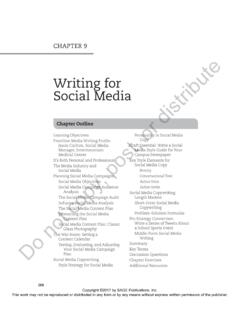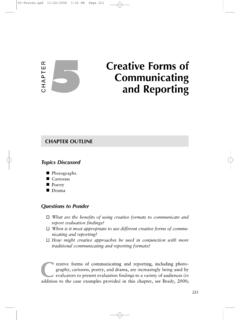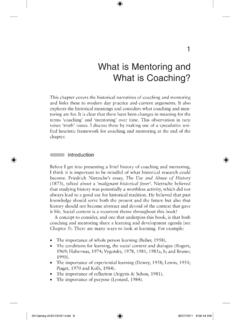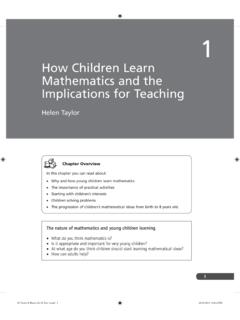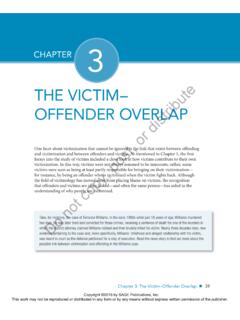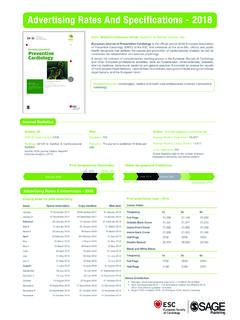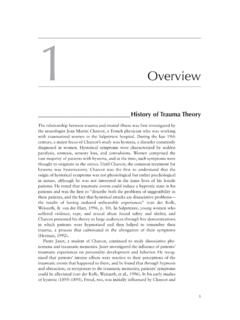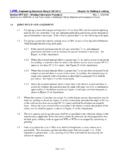Transcription of Quantitative Research Methods
1 Quantitative Research MethodsThis chapter focuses on Research designs commonly used when conducting Quantitative Research studies. The general purpose of Quantitative Research is to investigate a particular topic or activity through the measurement of variables in quantifiable terms. Quantitative approaches to conducting educational Research differ in numerous ways from the qualitative Methods we discussed in chapter 6. You will learn about these characteristics, the Quantitative Research process, and the specifics of several different approaches to conducting Quantitative Learning ObjectivesAfter studying chapter 7, students will be able to do the following:1. Describe the defining characteristics of Quantitative Research studies2. List and describe the basic steps in conducting Quantitative Research studies3. Identify and differentiate among various approaches to conducting Quantitative Research studies4. List and describe the steps and procedures in conducting survey, correlational, causal-comparative, quasi-experimental, experimental, and single-subject research5.
2 Identify and discuss the strengths and limitations of various approaches to conducting Quantitative research6. Identify and explain possible threats to both internal and external validity7. Design Quantitative Research studies for a topic of interest Copyright 2016 by SAGE Publications, Inc. This work may not be reproduced or distributed in any form or by any means without express written permission of the publisher. Do not copy, post, or distribute108 Part II Designing A Research StudyCharacteristics of Quantitative ResearchQuantitative Research relies on the collection and analysis of numerical data to describe, explain, predict, or control variables and phenomena of interest (Gay, Mills, & Airasian, 2009). One of the underlying tenets of Quantitative Research is a philosophical belief that our world is relatively stable and uniform, such that we can measure and understand it as well as make broad generalizations about it.
3 You should note right away the stark contrast between this belief and those of qualitative Research namely, that the world is ever changing and the role of the researcher is to adapt to and observe those constant changes. Gay and colleagues state that, from a Quantitative perspective, conclusions drawn about our world and its phenomena cannot be considered meaning-ful unless they can be verified through direct observation and measurement. Further, Quantitative researchers typically base their investigations on the belief that facts and feelings can be separated, and that the world exists as a single reality composed of facts that can be discovered through observation or other measurements (Fraenkel, Wallen, & Hyun, 2012). Yet again, this belief operates in stark contrast to the assump-tion held by qualitative researchers that individuals, in essence, are responsible for developing their own separate and unique realities of the same goal of Quantitative Research studies is vastly different from the qualitative goal of gaining a better understanding of a situation or event.
4 When conducting Quantitative Research studies, researchers seek to describe current situations, establish relationships between variables, and sometimes attempt to explain causal relationships between var-iables. This type of Research is truly focused on describing and explaining sometimes in a somewhat definitive manner the phenomenon under investigation (Creswell, 2005). Because of this singular perspective, Quantitative Research operates under widely agreed-on steps that guide the Research process (Fraenkel et al., 2012). The Quantitative Research process along with its various designs is fairly well established; there is lit-tle flexibility in terms of the strategies and techniques used. Quantitative researchers believe that nothing should be left to chance; therefore, no aspect of the Research design is permitted to emerge during the process, as it is in qualitative role undertaken by the Quantitative researcher is very different from that of his or her qualitative counterpart.
5 One of the goals of qualitative Research is for the researcher to become deeply immersed in the setting and among the participants. However, a major goal of Quantitative Research is for the researcher to remain as objective as possible (although, as we have previously discussed, all researchers have biases and it is more important that they recognize those biases and discuss their limitations). The much more linear steps in the Quantitative Research process as you will see shortly constitute the preestablished routines and strategies that help enhance researcher objectivity. This focus on objectivity is what enables the quan-titative researcher to generalize findings of a Research study beyond the particular situation ( , setting, school, participants) involved in that additional characteristics of Quantitative Research , summarized below, continue to differentiate its goals and strategies from those of qualitative Research (Creswell, 2005).
6 Copyright 2016 by SAGE Publications, Inc. This work may not be reproduced or distributed in any form or by any means without express written permission of the publisher. Do not copy, post, or distribute109 chapter 7 Quantitative Research Methods1. While the literature review serves as a justification for the Research problem regardless of the Research type, its role is much more central to the design of a quan-titative study than to that of a qualitative study. Not only does it provide background information for the study, but it serves to inform the methodologies, instrumentation, populations, and analytical techniques to be used in the The purpose of Quantitative studies is typically specific and narrow, focusing on only a handful of measurable variables. This is very different from the holistic perspective of qualitative Data collection is one of the most thoroughly established aspects of quantita-tive Research .
7 While these strategies may emerge during a qualitative study, they must be well developed prior to beginning a Quantitative Research study. Furthermore, in a Quantitative Research study, data collection instruments, procedures, and sampling strategies typically do not change once the study has begun. Quantitative Research -ers operate in this manner because they believe that it enhances the objectivity of their Quantitative sampling strategies differ drastically from those used in qualitative studies. Their focus in Quantitative studies is twofold: First, because generalizability of the results is a key aspect of Quantitative Research , sampling strategies tend to focus on the random selection of participants. Second, and again focusing on the idea of generalizing the results, Quantitative researchers typically collect data from a large number of individuals in their studies. As you will read in chapter 12, the reason for using large samples is to collect data from enough individuals that those data mirror the substantially larger population from which the sample was Techniques for data analysis and interpretation are entirely statistical in nature.
8 The focus is on the application of existing indices ( , calculating an average score), formulas ( , the formula for calculating a standard deviation), and statistical tests ( , an independent-samples t-test) that are consistent regardless of a particular topic or the variables being studied. In other words, if two researchers are analyzing the same Quantitative data set and both are calculating an average score, their calculated score will be identical. The same can be said for interpreting the results of statistical analy-ses. For example, when interpreting the average test score for two groups of students exposed to different instructional Methods , we would naturally interpret the higher average score to mean that that group outperformed the group with the lower average score. Of course, this is not the case when analyzing qualitative data, where interpre-tations can involve a great deal of subjectivity depending on the individual doing the analysis and interpretation.
9 This is yet another aspect of Quantitative Research Methods that introduces objectivity into the overall Research Finally, reporting the results of Quantitative Research almost always occurs in a standard, fixed format (as you will learn more about in chapter 14). The results are reported in an extremely objective and unbiased manner, having not been subjected to the inherent biases of the researcher. Copyright 2016 by SAGE Publications, Inc. This work may not be reproduced or distributed in any form or by any means without express written permission of the publisher. Do not copy, post, or distribute110 Part II Designing A Research StudyThe Quantitative Research ProcessThe general steps involved in the process of conducting any Research study as dis-cussed in Chapters 1 and 2 are typical for Quantitative Research studies. In nearly every Quantitative study, the steps are followed in sequential order. Furthermore, one step is usually completed before the subsequent step begins, especially when it comes to data collection, analysis, and interpretation.
10 Only once data collection has ceased does the analysis begin, followed upon its completion by the interpretation of those results. I will briefly reiterate the process, as it was presented in chapter Identification of the Research problem to be studied. As you have seen numerous times, clearly identifying a Research topic is the first step in any study. Quantitative Research studies tend to be narrow in scope, focusing on a handful of key variables. As has been previously noted, the purpose of any given study will often guide choices and decisions about the methodology to be employed in that Statement of one, or several, pertinent Research questions and/or hypotheses. The researcher must ensure that Research questions and hypotheses are stated clearly and precisely, as they will guide the remainder of the study. Failure to do so at the outset of the study can lead to problems that is, misalignment between Research questions and necessary data or between collected data and proposed analytical techniques as the study Review of related literature.

